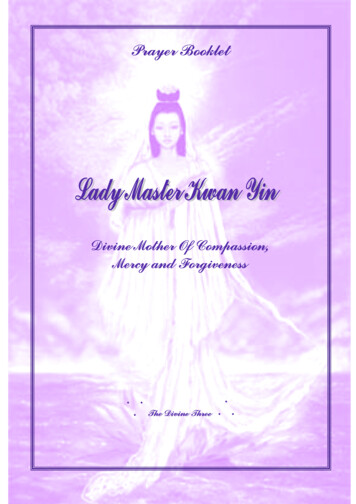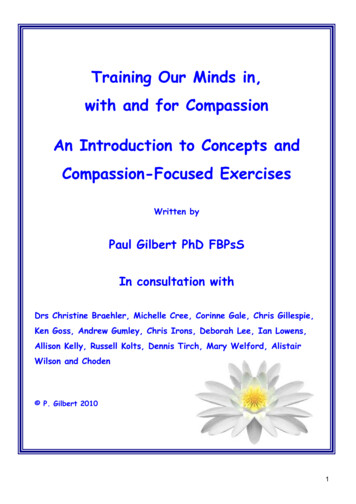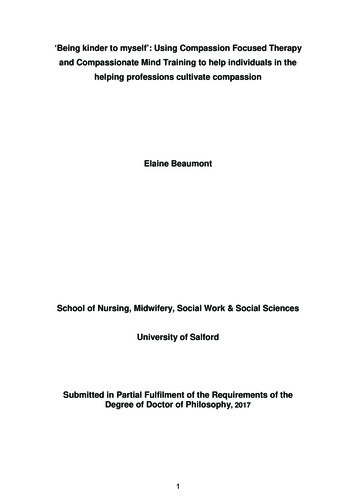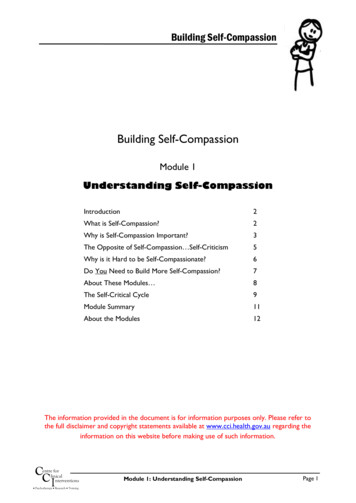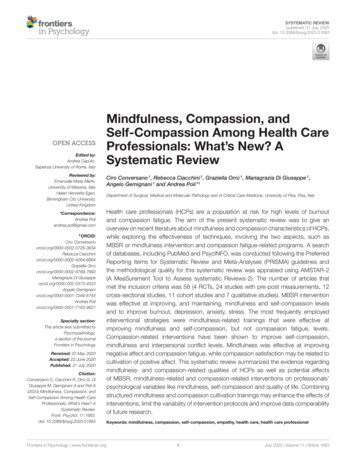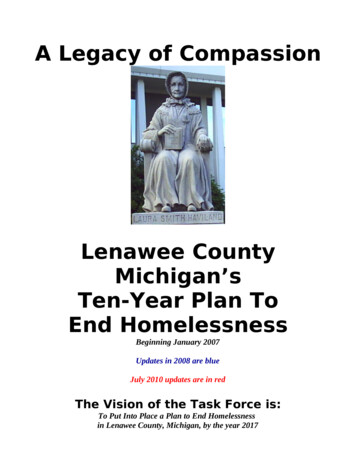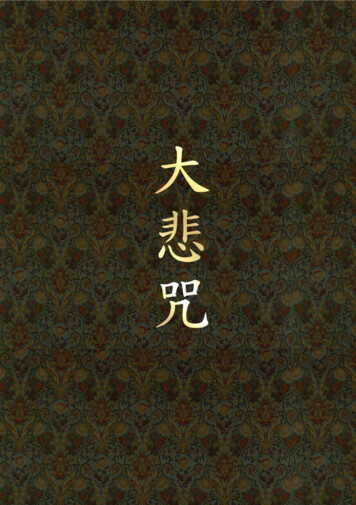
Transcription
南無觀世音菩薩NAMO GUANSHI YIN PUSA
GREATCOMPASSIONMANTRA大悲咒Dà Bēi Zhòu
Thousand-Armed Chenresi, a Cosmic Form of the Bodhisattva Avalokiteshvara(14th century, Tibet)Above script:Oṃ maṇi padme hūṃ (in Tibetan Uchen)
�心陀羅尼經Qiān Shǒu Qiān Yǎn Guānshìyīn PúsàGuǎngdà Yuánmǎn Wú Ài Dàbēi XīnTuóluóní JīngThe Sutra of the Infinite, PerfectedGreat Compassionate Heart of theThousand Armed Thousand EyedBodhisattva Avalokitesvara(A Dharani)Nīlakaṇṭha Dhāraṇī
Thousand-Arm Avalokitesvara(17th Century, Tibet)南無觀世音菩薩Namo Guanshi Yin PusaNamo Avalokitesvara
南無觀世音菩薩“The Bodhisattva Kuan Yin” (2009)By Wang Shuang-Kuan, 王雙寛In MemoriamWang Shuang-Kuan, 王雙寛
About theGreat Compassion MantraThe Great Compassion Mantra of Avalokitesvara (Kuan Yin) is adharani to be recited for purification, protection, and healing. Aconsecrated copy of the text is considered a powerful protectiontalisman. The dharani represents the spoken words of Kuan Yinas she recites the names of deities from many pantheons,including references to Shiva, Vishnu, and Indra. The GreatCompassion Mantra is bestowed upon us by Kuan Yin so that wemight overcome our suffering and—for those who seek it—achieve awakening.The image associated with the Great Compassion Mantra is einnumerable divine manifestations of Avalokitesvara and fromwhose body sprung the birth of many other divine beings. TheVenerable Master Hsuan Hua said of the Great CompassionMantra, “When you recite the Great Compassion Mantra, theheavens quake and the earth trembles as the mantra penetratesheaven and earth. If you recite it 108 times every day for athousand days, then the ten kings who are directors in the hells inthe courts of Yama are delighted,” further noting that the dharani“can relieve living beings of all their sufferings and difficulties Most important, it can cure illness With a sincere heart, youwill certainly obtain a response from the mantra.”
English Translationof theGreat Compassion MantraTrans. ByDaisetsu Teitaro Suzuki鈴木 大拙 貞太郎Adoration to the Triple Treasure:Adoration to Avalokiteśvara the Bodhisattva Mahāsattvawho is the great compassionate one.Om, to the one who performs a leap beyond all fears.Having adored him,may I enter into the heart of the blue-necked oneknown as the noble adorable Avalokiteśvara.It means the completion of all meaning;it is pure; it is that which makes all beings victoriousand cleanses the path of existence.Thus—Om, the seer, the world-transcending one.O Hari the Mahā bodhisattva.All, all:Defilement, defilement—The earth, the earth—It is the heart.
Do, do the work—Hold fast, hold fast—O great victor.Hold on, hold on—I hold on.To Indra the creator.Move, move, my defilement-free seal,Come, come.Hear, hear.A joy springs up in me.Speak, speak— Directing—Hulu, hulu, mala, hulu, hulu, hile.Sara, sara. Siri, siri. Suru, suru.Be awakened, be awakened.Have awakened, have awakened.O merciful one, blue-necked one—Of daring ones, to the joyous, hail.To the successful one, hail.To the great successful one, hail.To the one who has attainedmastery in the discipline, hail.To the blue-necked one, hail.To the boar-faced one, hail.To the one with a lion's head and face, hail.To the one who holds a weapon in his hand, hail.To the one who holds a wheel in his hand, hail.To the one who holds a lotus in his hand, hail.To the blue-necked far-causing one, hail.
To the beneficent onereferred to in this dhāraṇībeginning with Namo, hail.Adoration to the Triple Treasure:Adoration to Avalokiteśvara.Hail.May these prayers be successful.To this magical formula, hail.Note: Passages of the dharani could be interpreted as referencing a nāga, or shapeshifting serpent, often depicted as female. In Mahayana Buddhist mythology, nāgasare often associated with the directional guardian of the West. During a greatstorm, a nāga covered the Buddha’s head to give shelter while the Buddha wasmeditating. Buddha’s chief disciples are also referenced as nāgas. Awakening thekundalini is often associated with activating the inner nāga, expressed by theimage of a coiled serpent.
�心陀羅尼經 Qiān Shǒu Qiān YǎnGuānshìyīn PúsàGuǎngdà Yuánmǎn Wú ÀiDàbēi Xīn Tuóluóní JīngThe Sutra of the Infinite, Perfected GreatCompassionate Heart of the Thousand ArmedThousand Eyed Bodhisattva AvalokitesvaraNīlakaṇṭha DhāraṇīThe following Chinese translation is the Bhagavaddharma version ofthe Great Compassion Mantra dharani (Taishō Tripiṭaka 1060). TheTraditional Chinese text is printed right to left, top to bottom in verticallines. The left column text in larger font is the pin yin to be recited. Atthe bottom, after the pin yin in smaller font is the Siddam Sanskritversion.Note that on the last page of the recitation, discrepancies betweenSiddham Sanskrit and the Bhagavaddharma Chinese are due to originaldiscrepancies in the manuscript copy.According to Mahayana Buddhist doctrine, the Great CompassionMantra dharani should be recited as utterances of the sounds asprovided. Activation of the powers that be come from the utterances,not from superficial knowledge of the text’s meaning.The recitations are repeated 9 times, each time numbered at the top.Each recitation takes up 12 pages. When you read through the totalrecitations 12 times, you will have achieved 108 recitations of the GreatCompassion Mantra.
�薩千手千眼
1.ná mó ·hé là dá nā ·duō là yè yē。ná mó ·ā lì yē。pó lú jié dì ·shuò bō là yē。pú tí sà duǒ pó yē。mó hē sà duǒ pó yē。 na mo ra tna tra yā yana ma ā ryāva lo ki te śva rā yabo dhi sa tvā yama hā sa tvā �喝囉怛那·哆囉夜耶。
mó hē jiālú ní jiā yē。ōng。sà pó là fá yì。shù dá nādá xià。ná móxī jí lì duǒ·yī méngā lì yē。pó lú jí dì·shì fó làléng tuó pó。ná mó·nālà jǐn chí。 ma hā kāru ṇi kā ya.oṃ.sa rva ra bha ye.ṣu dha na da sya.na moskṛ ta ī mo ā ryāba ru ki teśi va raṃ dha vana mo na ra ki 迦耶。唵。
xī lì mó hē pó duōshā miē。sà pó ā tuō·dòushū péng。ā shì yùn。sà pó sà duō·ná mó pó sà duō·ná mó pó qié。mó fá tè dòu。dá zhí tuō。 he ri ma va dha ṣa mesa rva a tha du śu tuṃsa rva bhu ta na ma va gama va du duta dya 。阿逝孕。醯唎摩訶皤哆沙咩。
ōng。· ā pó lú xī。lú jiā dì。jiā luó dì。yí xī lì。mó hē pú tí sà duǒ。sà pó sà pó。mó là mó là。mó xī mó xī·lì tuó yùn。jù lú jù lú·jié méng。 oṃ. a va lo ka lo kā teka ra tee hṛema hābo dhi sa tva sa rvama la ma ma hṛe da yaṃku ru ka 迦羅帝。
dù lú dù lú·fá shé yē dì。mó hē fá shé yē dì。tuó là tuó là。dì lì ní。shì fó là yē。zhē là zhē là。mó mó·fá mó là。 dhu ru va ja ya tema hā va ja ya tedha radhi ri ṇirā yaca la ca lama mava ma 。度盧度盧·罰阇耶帝。
mù dì lì。yī xī yī xī。shì nā shì nā。ā là shēn·fó là shě lì。fá suō fá shēn。fó là shě yē。hū lú hū lú mó là。hū lú hū lú xī lì。 su kte lee he e heci ndaar ṣam pra ca liva ṣa va ṣaṃ pra śa yahu ru ma rahu 穆帝隸。伊醯伊醯。室那室那。
suō là suō là。xī lì xī lì。sū lú sū lú。pú tí yè·pú tí yè。pú tuó yè·pú tuó yè。mí dì lì yè。nā là jǐn chí。 sa ra si ri su rubo dhi yabo dha yamai tri yana ra ki ndi彌帝利夜。那囉謹墀。菩 菩 娑馱 提 囉夜 夜 娑。 · 囉菩 。提 悉夜 唎。 悉菩 唎馱 。夜 蘇· 嚧蘇嚧。
dì lì sè ní nā。pó yè mó nā。sā pó hē。xī tuó yè。sā pó hē。mó hē xī tuó yè。sā pó hē。xī tuó yù yì。 dha rṣi ṇi napa ṣa ma nasvā hā si ddhā yasvā hāma hā si ddhā yasvā hāsi ddha yo �。娑婆訶。
shì pó là yē。sā pó hē。nā là jǐn chí。sā pó hē。mó là nā là。sā pó hē。xī là sēng·ā mù qié yē。sā pó hē。sā pó mó hē·ā xī tuó yè。sā pó hē。 śva ka rā ya svā hāna ra ki ndisvā hā ma ra na rasvā hāsi ra saṃ ha mu khā yasvā hā pa ma hāsi ddhā yasvā �囉謹墀。
zhě jí là·ā xī tuó yè。sā pó hē。bō tuó mó·jié xī tuó yè。sā pó hē。nā là jǐn chí·pó qié là yē。 ca kra si ddhā yasvā hāpa dma ka stā yasvā hāna ra ki ndiva ga ra �訶。
sā pó hē。mó pó lì·shèng jié là yè。sā pó hē。ná mó hé là dá nā·duō là yè yē。ná mó ā lì yē。 svā hāma va ri śa nka ya svā hāna mo ra tna tra yā yana mo ā ryā va 。
pó lú jí dì。shuò pó là yè。sā pó hē。ōng·xī diàn dū。màn duō là。bá tuó yě。sā pó hē。 lo ki te śvarā ya bo dhi svā hā娑 唵 婆婆 · 嚧訶 悉 吉。 殿 帝都 。。 爍漫 皤多 囉囉 夜。 。跋 娑陀 婆耶 訶。 。
2.ná mó ·hé là dá nā ·duō là yè yē。ná mó ·ā lì yē。pó lú jié dì ·shuò bō là yē。pú tí sà duǒ pó yē。mó hē sà duǒ pó yē。 na mo ra tna tra yā yana ma ā ryāva lo ki te śva rā yabo dhi sa tvā yama hā sa tvā �喝囉怛那·哆囉夜耶。
mó hē jiālú ní jiā yē。ōng。sà pó là fá yì。shù dá nādá xià。ná móxī jí lì duǒ·yī méngā lì yē。pó lú jí dì·shì fó làléng tuó pó。ná mó·nālà jǐn chí。 ma hā kāru ṇi kā ya.oṃ.sa rva ra bha ye.ṣu dha na da sya.na moskṛ ta ī mo ā ryāba ru ki teśi va raṃ dha vana mo na ra ki 迦耶。唵。
xī lì mó hē pó duōshā miē。sà pó ā tuō·dòushū péng。ā shì yùn。sà pó sà duō·ná mó pó sà duō·ná mó pó qié。mó fá tè dòu。dá zhí tuō。 he ri ma va dha ṣa mesa rva a tha du śu tuṃsa rva bhu ta na ma va gama va du duta dya 。阿逝孕。醯唎摩訶皤哆沙咩。
ōng。· ā pó lú xī。lú jiā dì。jiā luó dì。yí xī lì。mó hē pú tí sà duǒ。sà pó sà pó。mó là mó là。mó xī mó xī·lì tuó yùn。jù lú jù lú·jié méng。 oṃ. a va lo ka lo kā teka ra tee hṛema hābo dhi sa tva sa rvama la ma ma hṛe da yaṃku ru ka 迦羅帝。
dù lú dù lú·fá shé yē dì。mó hē fá shé yē dì。tuó là tuó là。dì lì ní。shì fó là yē。zhē là zhē là。mó mó·fá mó là。 dhu ru va ja ya tema hā va ja ya tedha radhi ri ṇirā yaca la ca lama mava ma 。度盧度盧·罰阇耶帝。
mù dì lì。yī xī yī xī。shì nā shì nā。ā là shēn·fó là shě lì。fá suō fá shēn。fó là shě yē。hū lú hū lú mó là。hū lú hū lú xī lì。 su kte lee he e heci ndaar ṣam pra ca liva ṣa va ṣaṃ pra śa yahu ru ma rahu 穆帝隸。伊醯伊醯。室那室那。
suō là suō là。xī lì xī lì。sū lú sū lú。pú tí yè·pú tí yè。pú tuó yè·pú tuó yè。mí dì lì yè。nā là jǐn chí。 sa ra si ri su rubo dhi yabo dha yamai tri yana ra ki ndi彌帝利夜。那囉謹墀。菩 菩 娑馱 提 囉夜 夜 娑。 · 囉菩 。提 悉夜 唎。 悉菩 唎馱 。夜 蘇· 嚧蘇嚧。
dì lì sè ní nā。pó yè mó nā。sā pó hē。xī tuó yè。sā pó hē。mó hē xī tuó yè。sā pó hē。xī tuó yù yì。 dha rṣi ṇi napa ṣa ma nasvā hā si ddhā yasvā hāma hā si ddhā yasvā hāsi ddha yo �。娑婆訶。
shì pó là yē。sā pó hē。nā là jǐn chí。sā pó hē。mó là nā là。sā pó hē。xī là sēng·ā mù qié yē。sā pó hē。sā pó mó hē·ā xī tuó yè。sā pó hē。 śva ka rā ya svā hāna ra ki ndisvā hā ma ra na rasvā hāsi ra saṃ ha mu khā yasvā hā pa ma hāsi ddhā yasvā �囉謹墀。
zhě jí là·ā xī tuó yè。sā pó hē。bō tuó mó·jié xī tuó yè。sā pó hē。nā là jǐn chí·pó qié là yē。 ca kra si ddhā yasvā hāpa dma ka stā yasvā hāna ra ki ndiva ga ra �訶。
sā pó hē。mó pó lì·shèng jié là yè。sā pó hē。ná mó hé là dá nā·duō là yè yē。ná mó ā lì yē。 svā hāma va ri śa nka ya svā hāna mo ra tna tra yā yana mo ā ryā va 。
pó lú jí dì。shuò pó là yè。sā pó hē。ōng·xī diàn dū。màn duō là。bá tuó yě。sā pó hē。 lo ki te śvarā ya bo dhi svā hā娑 唵 婆婆 · 嚧訶 悉 吉。 殿 帝都 。。 爍漫 皤多 囉囉 夜。 。跋 娑陀 婆耶 訶。 。
3.ná mó ·hé là dá nā ·duō là yè yē。ná mó ·ā lì yē。pó lú jié dì ·shuò bō là yē。pú tí sà duǒ pó yē。mó hē sà duǒ pó yē。 na mo ra tna tra yā yana ma ā ryāva lo ki te śva rā yabo dhi sa tvā yama hā sa tvā �喝囉怛那·哆囉夜耶。
mó hē jiālú ní jiā yē。ōng。sà pó là fá yì。shù dá nādá xià。ná móxī jí lì duǒ·yī méngā lì yē。pó lú jí dì·shì fó làléng tuó pó。ná mó·nālà jǐn chí。 ma hā kāru ṇi kā ya.oṃ.sa rva ra bha ye.ṣu dha na da sya.na moskṛ ta ī mo ā ryāba ru ki teśi va raṃ dha vana mo na ra ki 迦耶。唵。
xī lì mó hē pó duōshā miē。sà pó ā tuō·dòushū péng。ā shì yùn。sà pó sà duō·ná mó pó sà duō·ná mó pó qié。mó fá tè dòu。dá zhí tuō。 he ri ma va dha ṣa mesa rva a tha du śu tuṃsa rva bhu ta na ma va gama va du duta dya 。阿逝孕。醯唎摩訶皤哆沙咩。
ōng。· ā pó lú xī。lú jiā dì。jiā luó dì。yí xī lì。mó hē pú tí sà duǒ。sà pó sà pó。mó là mó là。mó xī mó xī·lì tuó yùn。jù lú jù lú·jié méng。 oṃ. a va lo ka lo kā teka ra tee hṛema hābo dhi sa tva sa rvama la ma ma hṛe da yaṃku ru ka 迦羅帝。
dù lú dù lú·fá shé yē dì。mó hē fá shé yē dì。tuó là tuó là。dì lì ní。shì fó là yē。zhē là zhē là。mó mó·fá mó là。 dhu ru va ja ya tema hā va ja ya tedha radhi ri ṇirā yaca la ca lama mava ma 。度盧度盧·罰阇耶帝。
mù dì lì。yī xī yī xī。shì nā shì nā。ā là shēn·fó là shě lì。fá suō fá shēn。fó là shě yē。hū lú hū lú mó là。hū lú hū lú xī lì。 su kte lee he e heci ndaar ṣam pra ca liva ṣa va ṣaṃ pra śa yahu ru ma rahu 穆帝隸。伊醯伊醯。室那室那。
suō là suō là。xī lì xī lì。sū lú sū lú。pú tí yè·pú tí yè。pú tuó yè·pú tuó yè。mí dì lì yè。nā là jǐn chí。 sa ra si ri su rubo dhi yabo dha yamai tri yana ra ki ndi彌帝利夜。那囉謹墀。菩 菩 娑馱 提 囉夜 夜 娑。 · 囉菩 。提 悉夜 唎。 悉菩 唎馱 。夜 蘇· 嚧蘇嚧。
dì lì sè ní nā。pó yè mó nā。sā pó hē。xī tuó yè。sā pó hē。mó hē xī tuó yè。sā pó hē。xī tuó yù yì。 dha rṣi ṇi napa ṣa ma nasvā hā si ddhā yasvā hāma hā si ddhā yasvā hāsi ddha yo �。娑婆訶。
shì pó là yē。sā pó hē。nā là jǐn chí。sā pó hē。mó là nā là。sā pó hē。xī là sēng·ā mù qié yē。sā pó hē。sā pó mó hē·ā xī tuó yè。sā pó hē。 śva ka rā ya svā hāna ra ki ndisvā hā ma ra na rasvā hāsi ra saṃ ha mu khā yasvā hā pa ma hāsi ddhā yasvā �囉謹墀。
zhě jí là·ā xī tuó yè。sā pó hē。bō tuó mó·jié xī tuó yè。sā pó hē。nā là jǐn chí·pó qié là yē。 ca kra si ddhā yasvā hāpa dma ka stā yasvā hāna ra ki ndiva ga ra �訶。
sā pó hē。mó pó lì·shèng jié là yè。sā pó hē。ná mó hé là dá nā·duō là yè yē。ná mó ā lì yē
The Great Compassion Mantra of Avalokitesvara (Kuan Yin) is a dharani to be recited for purification, protection, and healing. A consecrated copy of the text is considered a powerful protection talisman. The dharani represents the spoken words of Kuan Yin as she recites the names of

